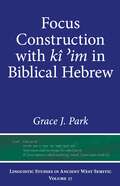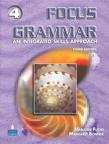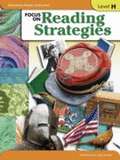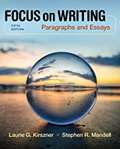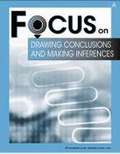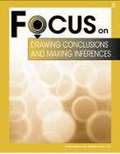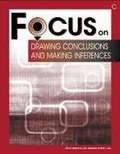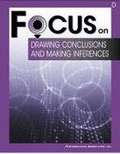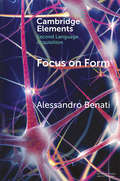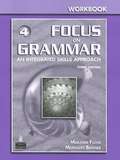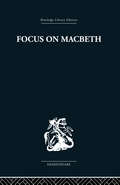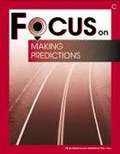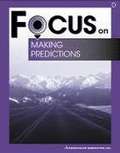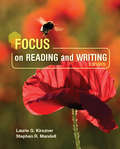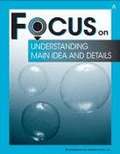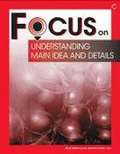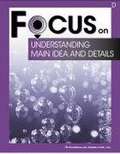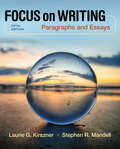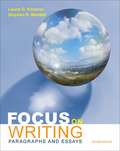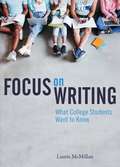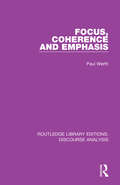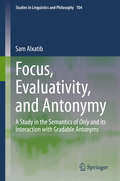- Table View
- List View
Focus Construction with kî ʾim in Biblical Hebrew (Linguistic Studies in Ancient West Semitic)
by Grace J. ParkThis study uses modern linguistic theory to analyze a frequently recurring syntactic phenomenon in the Hebrew Bible that has thus far resisted explanation: כי אם.The combination of the two particles כי and אם produces a construction that is notoriously difficult to describe, analyze syntactically, and translate. Dictionaries of Biblical Hebrew offer a dizzying variety of translations for this construction, including “that if,” “except,” “unless,” “but,” “but only,” and “surely,” among other possibilities. In this book, Grace J. Park provides a new approach that strives for greater precision and consistency in translation. Park argues that כי אם is used in three patterns: the “full focus” pattern, the “reduced focus” pattern, and the less common “non-focus” pattern. Her syntactic analysis of all 156 occurrences of the כי אם construction in the Bible lends greater clarity to the contested passages.Drawing on recent linguistic research into the typology of clausal nominalization as well as previous work on contrastive focus, this innovative project provides important new insight into the syntax of Biblical Hebrew. It will be especially valuable for scholars seeking to translate כי אם more consistently and accurately.
Focus Literature (Grade #7)
by GlencoeA book for grade 7 students to improve their literature through the poems, short stories, plays, and novels provided in this book.
Focus Manifestation in Mandarin Chinese and Cantonese: A Comparative Perspective (Routledge Studies in Chinese Linguistics)
by Peppina Po-lun LeeOne prominent function of natural language is to convey information. One peculiarity is that it does not do so randomly, but in a structured way, with information structuring formally recognized to be a component of grammar. Among all information structuring notions, focus is one primitive needed to account for all phenomena. Focus Manifestation in Mandarin Chinese and Cantonese: A Comparative Perspective aims to examine from a semantic perspective how syntactic structures and focus adverbs in Mandarin Chinese and semantic particles in Cantonese conspire to encode focus structures and determine focus manifestation in Chinese. With both as tonal languages, Mandarin Chinese and Cantonese manifest different morpho-syntactic configurations to mark focus. A general principle governing focus marking in Mandarin Chinese and Cantonese is given in the book, which aims to give a better understanding on the underlying principles the two used to mark additive and restrictive meanings, and related focus interpretations. Particular attention is also drawn to the co-occurrence of multiple forms of restrictive and additive particles in Cantonese, including adverbs, verbal suffixes and sentence-final particles. Linearity has shown to be an important parameter to determine how focus is structured in Cantonese. This book is aimed at advanced graduate students, researchers and scholars working on Chinese linguistics, syntax and semantics, and comparative dialectal grammar.
Focus On Grammar: Level 4
by Marjorie Fuchs Margaret BonnerWith a fresh new design and a host of updated exercises and activities, the popular Focus on Grammar series is more practical and accessible than ever. Known for its focus on English grammar through contextualized listening, speaking, reading, and writing activities, this lively integrated skills course helps students bridge the gap between comprehending grammatical structures and actually using them. Centered on thematic instruction, Focus on Grammar combines controlled and communicative practice in a consistent approach that's a proven success among students at all levels. Each unit progresses through four steps: Grammar in Context, Grammar Presentation, Focused Practice, and Communication Practice, using a unique format that makes the program easy for students to understand - and for teachers to implement. Each Student Book features: * Clear presentations and charts that make grammar easy to learn. * Creative activities that stimulate communication. *New high-interest readings that are rich in content. *From Grammar to Writing sections that build composition skills. *Review Tests to confirm progress and improve scores on standardized tests. *New Internet activities for individual, pair, or group work.
Focus On Reading Strategies Level H
by PLC Editors StaffFocus On Reading Strategies, Grade 8: A language arts textbook
Focus On Writing: Paragraphs and Essays
by Laurie G. Kirszner Stephen R. MandellFocus on Writing: Paragraphs and Essays, new from best-selling authors Laurie Kirszner and Stephen Mandell, is their most accessible writing text yet. Focus on Writing engages students visually, demonstrates concepts with color and highlighting, and offers students more grammar support than any comparable text on the market. This text provides the same excellent coverage that Kirszner and Mandell’s popular workbook series, Foundations First: Sentences and Paragraphs and Writing First: Practice in Context are known for, while also responding to students’ changing needs and realities. It offers more step-by-step coverage of the writing process and more diverse examples, exercises, and models, making it both student-friendly and thorough. Working clearly and simply to engage and motivate students, Focus on Writing empowers students to become capable writers and self-editors who are prepared for college composition.
Focus on Drawing Conclusions and Making Inferences: Book A
by Curriculum AssociatesFill a comprehension skill gap with brief instruction and concentrated practice. Each skill book includes modeled instruction, guided and independent practice. Students answer selected- and constructed-response questions.
Focus on Drawing Conclusions and Making Inferences: Book B
by Curriculum AssociatesFill a comprehension skill gap with brief instruction and concentrated practice. Each skill book includes modeled instruction, guided and independent practice. Students answer selected- and constructed-response questions.
Focus on Drawing Conclusions and Making Inferences: Book C
by Curriculum AssociatesFill a comprehension skill gap with brief instruction and concentrated practice. Each skill book includes modeled instruction, guided and independent practice. Students answer selected- and constructed-response questions.
Focus on Drawing Conclusions and Making Inferences: Book D
by Curriculum AssociatesFill a comprehension skill gap with brief instruction and concentrated practice. Each skill book includes modeled instruction, guided and independent practice. Students answer selected- and constructed-response questions.
Focus on Form (Elements in Second Language Acquisition)
by Alessandro BenatiThis Cambridge Element examines the role and nature of focus on form in second language acquisition. An overall assessment of the role of instruction and the nature of language is provided. Instruction might have a facilitative role in the rate of acquisition. The element briefly reviews empirical research examining the relative effects of different types of focus on form and presents some of the key implications for second language learning and teaching. An effective focus on form type is one that is input and meaning oriented. Manipulating input to facilitate language processing and form-meaning connections might enhance second language acquisition.
Focus on Grammar Level 4 Workbook: An Integrated Skills Approach
by Marjorie Fuchs Margaret BonnerThe Workbook accompanying each level of Focus on Grammar provides additional exercises for self-study of the target grammar for each unit. Tests included in each Workbook provide students with additional opportunities for self-assessment. Focus on Grammar helps students understand and practice English grammar through contextualized listening, speaking, reading, and writing activities. Focus on Grammar combines controlled and communicative practice with critical thinking skills and ongoing assessment.
Focus on Macbeth
by John Russell BrownFirst published in 1982. Macbeth exercises a strange influence over readers and theatre audiences: the words of the text offer no easy clue to meaning or significance and in dramatic structure the play is very different from other Shakespearean tragedies. Many kinds of study are needed in order to understand the tragedy of Macbeth and this book provides a wide range of studies that respect the individuality of the text and examine it from different viewpoints. Contents include: Themes and Structure; Characterization and Narrative, Visual Effects, Performance in the Eighteenth, Nineteenth and Twentieth Centuries; Historical and Political Background; Role of Witchcraft; Game Theory. Contributors include: John Russell Brown, Derek Russell Davis, Gareth Lloyd Evans, R A Foakes, Michael Goldman, Robin Grove, Peter Hall, Michael Hawkins, Brian Morris, D J Palmer, Marvin Rosenberg and Peter Stallybrass.
Focus on Making Predictions: Book C
by Curriculum AssociatesFill a comprehension skill gap with brief instruction and concentrated practice. Each skill book includes modeled instruction, guided and independent practice. Students answer selected- and constructed-response questions.
Focus on Making Predictions: Book D
by Curriculum AssociatesFill a comprehension skill gap with brief instruction and concentrated practice. Each skill book includes modeled instruction, guided and independent practice. Students answer selected- and constructed-response questions.
Focus on Reading and Writing
by Laurie G. Kirszner Stephen R. MandellFocus on Reading and Writing is a new book by veteran author team Laurie G. Kirszner and Stephen R. Mandell and in collaboration with two reading specialists. It provides thorough, integrated instruction on reading and writing essays and includes several effective features to help students make the connection between the reading and writing processes, including TEST--Kirszner and Mandell's simple and effective reading and writing tool designed to help students gauge their progress. Kirszner and Mandell believe that students learn best when they try their hand at a new concept first with their own work. That's why they designed the Focus on Reading and Writing strand throughout each chapter. This strand first prompts students to read and write, then learn essential concepts, and ultimately apply those concepts while re-reading and revising. With a complete grammar guide, supplementary online grammar practice, and 23 professional reading selections, this comprehensive text gets students reading, writing, and thinking critically in preparation for academic, career, and life success.
Focus on Reading and Writing: Essays
by Laurie Kirszner Stephen MandellFocus on Reading and Writing: Essays provides thorough, integrated instruction on reading and writing essays and includes many effective features to help students make the connection between the reading and writing processes, including TEST—Kirszner and Mandell’s simple and effective reading and writing tool designed to help students gauge their progress. Kirszner and Mandell believe that students learn best when they try their hand at a new concept first with their own work. That’s why they designed the Focus on Reading and Writing strand throughout each chapter. The strand first prompts students to read and write, then learn essential concepts, and ultimately apply those concepts while re-reading and revising. With a complete grammar guide, supplementary online grammar practice through LaunchPad Solo for Readers and Writers, and 23 professional reading selections, this comprehensive text gets students reading, writing, and thinking critically in preparation for academic, career, and life success. The Second Edition strengthens and further integrates reading coverage throughout, helping improve students’ comprehension and ability to think critically as they read. An updated TEST feature now applies equally to understanding and analyzing readings as well as developing, drafting, and revising essays, a new annotated model has been added in Chapter 1, and new information has been added on identifying and formulating implied main ideas.
Focus on Understanding Main Ideas and Details: Book A
by Curriculum AssociatesFill a comprehension skill gap with brief instruction and concentrated practice. Each skill book includes modeled instruction, guided and independent practice. Students answer selected- and constructed-response questions.
Focus on Understanding Main Ideas and Details: Book C
by Curriculum AssociatesFill a comprehension skill gap with brief instruction and concentrated practice. Each skill book includes modeled instruction, guided and independent practice. Students answer selected- and constructed-response questions.
Focus on Understanding Main Ideas and Details: Book D
by Curriculum AssociatesFill a comprehension skill gap with brief instruction and concentrated practice. Each skill book includes modeled instruction, guided and independent practice. Students answer selected- and constructed-response questions.
Focus on Writing: Paragraphs and Essays
by Laurie Kirszner Stephen MandellFocus on Writing offers clear, thorough coverage of college writing, with a chapter design that puts writing first. The Focus on Writing strand in Chapters 2-17 prompts students to write, learn essential concepts as they follow a student model, and apply those concepts to their own writing in a series of manageable steps. The text also empowers students with a unique tool for assessing and revising their work: the easy-to-grasp, easy-to-remember TEST (Topic sentence or Thesis statement, Evidence, Summary statement, and Transitions). A complete three-in-one text, Focus on Writing not only covers the process of writing paragraphs and essays but also includes a grammar guide with exercises and an essay collection. Supplementary online grammar practice through LaunchPad Solo for Readers and Writers rounds out this complete package.
Focus on Writing: Paragraphs and Essays (2nd edition)
by Laurie G. Kirszner Stephen R. MandellFocus on Writing: Paragraphs and Essays is a clear, inviting text that engages students visually, demonstrates concepts with color and highlighting, and offers students the support and coverage they need to write well in college. Focus on Writing offers the unique self-assessment tool TEST (Topic sentence,Evidence,Summary statement, and Transitions), which works clearly and simply to motivate students and empowers them to become capable writers and self-editors. In this revision, best-selling authors Laurie Kirszner and Stephen Mandell provide more support for moving from paragraph to essay, more step-by-step coverage of the writing process, and more diverse examples, exercises, and models, making the text both student-friendly and thorough.
Focus on Writing: What College Students Want to Know
by Laurie McMillanThis first-year composition rhetoric-reader uses a Writing about Writing (WAW) approach and a conversational style to help students engage in threshold concepts and transfer what they know about writing to new situations. Each chapter asks a key question such as “Why Write?” or “What Is the Rhetorical Situation and Why Should I Care about It?” Preliminary answers to the chapter question are provided in accessible prose, and these initial ideas are supplemented with a selection of three or four readings and a list of recommended online texts. Prompts for informal and formal writing projects keep the focus on writing and help students apply writing studies scholarship to their own lives in meaningful ways.
Focus, Coherence and Emphasis (RLE: Discourse Analysis)
by Paul WerthFirst published in 1984, this book examines a number of questions on the boundary of competence and performance — whose solutions have implications for linguistic theory in general. In particular, the form of grammatical statements, the relationship between various rules of grammar, the interaction between sentence in a sequence, and the inferences to be drawn from linguistic behaviour to linguistic knowledge. The author argues that many grammatical processes, inadequately handled by conventional sentence-grammars, require a text grammar in which the basic constitutive processes of information and deixis can be specified. They ago further to investigate the novel hypothesis that emphatic structure provides a crucial condition for the application of transformational rules, paying particular attention to the ‘movement-rules’ using mostly data culled from actual usage.
Focus, Evaluativity, and Antonymy: A Study in the Semantics of Only and its Interaction with Gradable Antonyms (Studies in Linguistics and Philosophy #104)
by Sam AlxatibThis book uncovers properties of focus association with 'only' by examining the interaction between the particle and bare (or “evaluative”) gradable terms. Its empirical building blocks are paradigms involving upward-scalar terms like 'few' and 'rarely', and their downward-scalar antonyms 'many' and 'frequently', an area that has not been studied previously in the literature. The empirical claim is that associations of the former type give rise to unexpected readings, and the proposed theoretical explanation draws on the properties of the latter type of association. In presenting the details, the book deconstructs the so-called scalar presupposition of 'only' and derives it from constraints against its vacuous use. This view is then combined with a semantics of the evaluative adjectives 'many' and 'few' to explain why the unavailable (but expected) meanings of the given constructions are unavailable. The attested (but unexpected) readings of 'only+few/rarely' associations are derived from independently motivated LFs in which the degree expressions are existentially closed. Finally, the book provides new findings, based on the core proposal, about 'only if' constructions, and about the interaction between 'only' and other upward-scalar modified numerals (comparatives, and 'at most'). The book thus provides new data and a new theoretical view of the semantic properties of 'only', and connects it to the semantics of gradable expressions.
